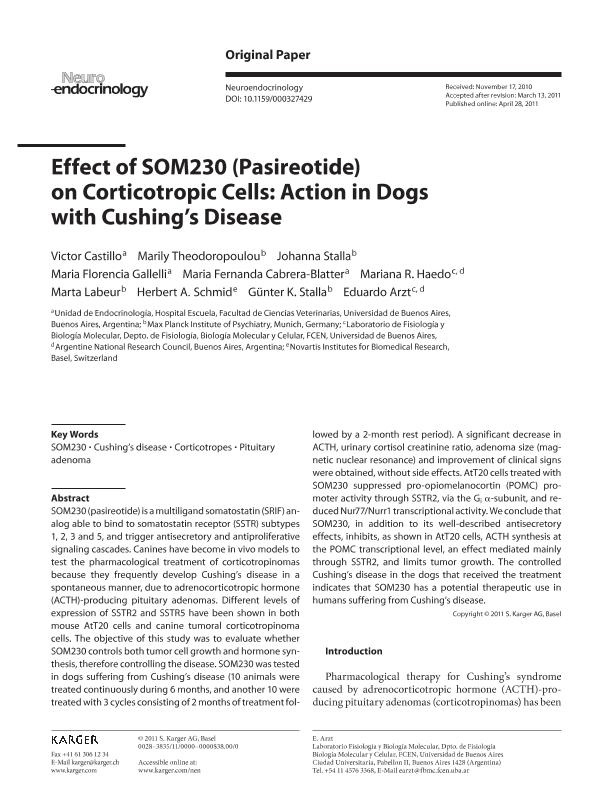Mostrar el registro sencillo del ítem
dc.contributor.author
Castillo, Victor
dc.contributor.author
Theodoropoulou, Marily
dc.contributor.author
Stalla, Johanna
dc.contributor.author
Gallelli, Maria Florencia

dc.contributor.author
Cabrera Blatter, Maria Fernanda
dc.contributor.author
Haedo, Mariana Raquel

dc.contributor.author
Labeur, Marta
dc.contributor.author
Schmid, Herbert A.
dc.contributor.author
Stalla, Günter K.
dc.contributor.author
Arzt, Eduardo Simon

dc.date.available
2019-01-30T14:52:49Z
dc.date.issued
2011-09
dc.identifier.citation
Castillo, Victor; Theodoropoulou, Marily; Stalla, Johanna; Gallelli, Maria Florencia; Cabrera Blatter, Maria Fernanda; et al.; Effect of SOM230 (Pasireotide) on corticotropic cells: Action in dogs with Cushing's disease; Karger; Neuroendocrinology; 94; 2; 9-2011; 124-136
dc.identifier.issn
0028-3835
dc.identifier.uri
http://hdl.handle.net/11336/68973
dc.description.abstract
SOM230 (pasireotide) is a multiligand somatostatin (SRIF) analog able to bind to somatostatin receptor (SSTR) subtypes 1, 2, 3 and 5, and trigger antisecretory and antiproliferative signaling cascades. Canines have become in vivo models to test the pharmacological treatment of corticotropinomas because they frequently develop Cushing's disease in a spontaneous manner, due to adrenocorticotropic hormone (ACTH)-producing pituitary adenomas. Different levels of expression of SSTR2 and SSTR5 have been shown in both mouse AtT20 cells and canine tumoral corticotropinoma cells. The objective of this study was to evaluate whether SOM230 controls both tumor cell growth and hormone synthesis, therefore controlling the disease. SOM230 was tested in dogs suffering from Cushing's disease (10 animals were treated continuously during 6 months, and another 10 were treated with 3 cycles consisting of 2 months of treatment followed by a 2-month rest period). A significant decrease in ACTH, urinary cortisol creatinine ratio, adenoma size (magnetic nuclear resonance) and improvement of clinical signs were obtained, without side effects. AtT20 cells treated with SOM230 suppressed pro-opiomelanocortin (POMC) promoter activity through SSTR2, via the G i α-subunit, and reduced Nur77/Nurr1 transcriptional activity. We conclude that SOM230, in addition to its well-described antisecretory effects, inhibits, as shown in AtT20 cells, ACTH synthesis at the POMC transcriptional level, an effect mediated mainly through SSTR2, and limits tumor growth. The controlled Cushing's disease in the dogs that received the treatment indicates that SOM230 has a potential therapeutic use in humans suffering from Cushing's disease.
dc.format
application/pdf
dc.language.iso
eng
dc.publisher
Karger

dc.rights
info:eu-repo/semantics/openAccess
dc.rights.uri
https://creativecommons.org/licenses/by-nc-sa/2.5/ar/
dc.subject
Corticotropes
dc.subject
Cushing'S Disease
dc.subject
Pituitary Adenoma
dc.subject
Som231
dc.title
Effect of SOM230 (Pasireotide) on corticotropic cells: Action in dogs with Cushing's disease
dc.type
info:eu-repo/semantics/article
dc.type
info:ar-repo/semantics/artículo
dc.type
info:eu-repo/semantics/publishedVersion
dc.date.updated
2019-01-29T18:04:55Z
dc.journal.volume
94
dc.journal.number
2
dc.journal.pagination
124-136
dc.journal.pais
Suiza

dc.journal.ciudad
Basilea
dc.description.fil
Fil: Castillo, Victor. Universidad de Buenos Aires. Facultad de Ciencias Veterinarias; Argentina
dc.description.fil
Fil: Theodoropoulou, Marily. Max Planck Institute of Psychiatry; Alemania
dc.description.fil
Fil: Stalla, Johanna. Max Planck Institute of Psychiatry; Alemania
dc.description.fil
Fil: Gallelli, Maria Florencia. Universidad de Buenos Aires. Facultad de Ciencias Veterinarias; Argentina. Consejo Nacional de Investigaciones Científicas y Técnicas; Argentina
dc.description.fil
Fil: Cabrera Blatter, Maria Fernanda. Universidad de Buenos Aires. Facultad de Ciencias Veterinarias; Argentina
dc.description.fil
Fil: Haedo, Mariana Raquel. Universidad de Buenos Aires. Facultad de Ciencias Exactas y Naturales. Departamento de Fisiología, Biología Molecular y Celular. Laboratorio de Fisiología y Biología Molecular; Argentina. Consejo Nacional de Investigaciones Científicas y Técnicas; Argentina
dc.description.fil
Fil: Labeur, Marta. Max Planck Institute of Psychiatry; Alemania
dc.description.fil
Fil: Schmid, Herbert A.. Novartis Institutes for Biomedical Research; Suiza
dc.description.fil
Fil: Stalla, Günter K.. Max Planck Institute of Psychiatry; Alemania
dc.description.fil
Fil: Arzt, Eduardo Simon. Universidad de Buenos Aires. Facultad de Ciencias Exactas y Naturales. Departamento de Fisiología, Biología Molecular y Celular. Laboratorio de Fisiología y Biología Molecular; Argentina. Consejo Nacional de Investigaciones Científicas y Técnicas; Argentina
dc.journal.title
Neuroendocrinology

dc.relation.alternativeid
info:eu-repo/semantics/altIdentifier/doi/http://dx.doi.org/10.1159/000327429
dc.relation.alternativeid
info:eu-repo/semantics/altIdentifier/url/https://www.karger.com/Article/Abstract/327429
Archivos asociados
